Yamaha RX-V590 User Manual
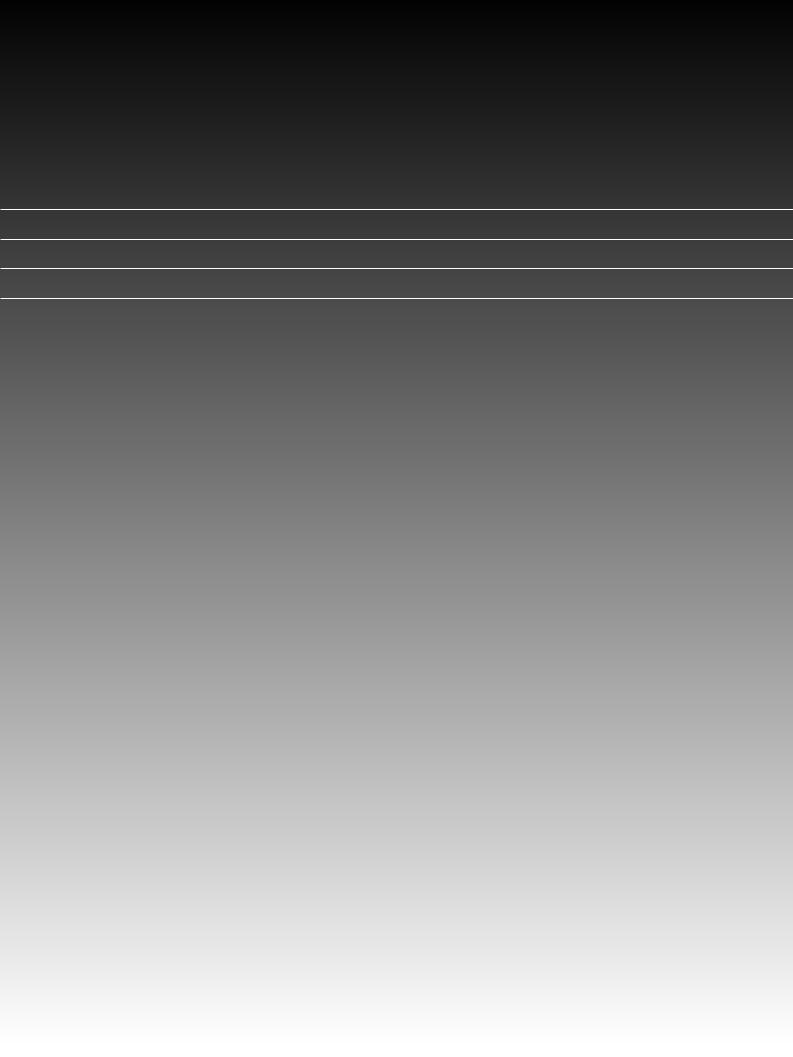





 RX-V590
RX-V590
Natural Sound Stereo Receiver
Récepteur stéréo “Son Naturel”
Receptor estéreo de Sonido Natural
OWNER’S MANUAL MODE D’EMPLOI MANUAL DE INSTRUCCIONES
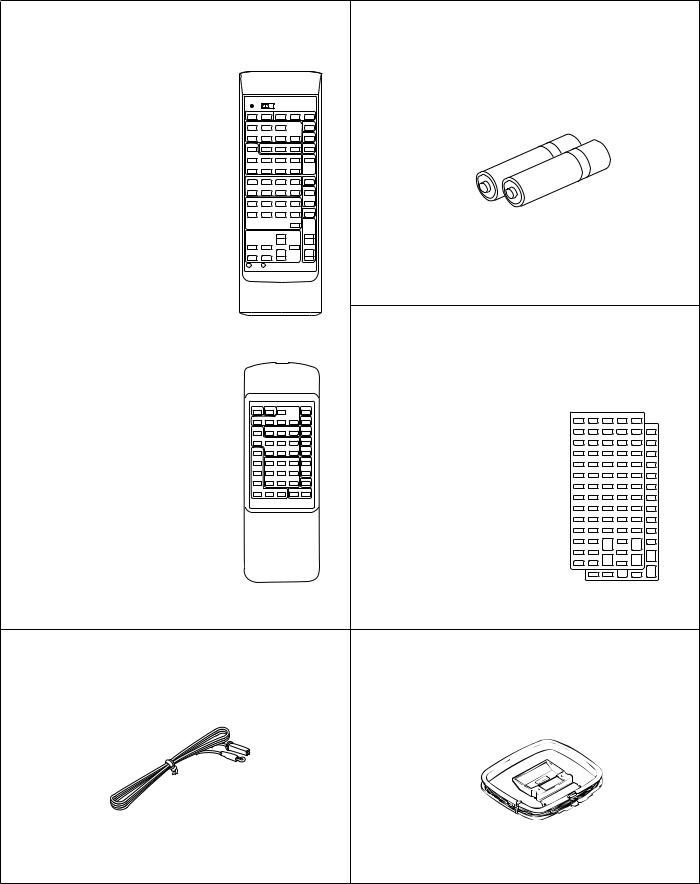
SUPPLIED ACCESSORIES ACCESSOIRES FOURNIS ACCESORIOS INCLUIDOS
●After unpacking, check that the following parts are included.
●Après le déballage, vérifier que les pièces suivantes sont incluses.
●Desembale el aparato y verificar que los siguientes accesorios están en la caja.
● |
Remote Control Transmitter |
● |
Batteries (size AA, R6, UM-3) |
● |
Emetteur de télécommande |
● |
Piles (taille AA, R6, UM-3) |
● |
Transmisor del control remoto |
● |
Pilas (tamaño AA, R6, UM-3) |
|
(U.S.A., Canada and Australia |
|
|
|
models) |
|
|
|
(Modèles pour les Etats-Unis, |
|
|
|
le Canada et l’Australie) |
|
|
|
(Modelos para EE.UU., Canadá y |
|
|
|
Australia) |
|
|
● |
User Program Sheets |
|
(U.S.A., Canada and Australia |
|
models only) |
● |
Feuilles de programmation |
(General model) |
(Modèles pour les Etats-Unis, |
(Modèle général) |
le Canada et l’Australie |
(Modelo general) |
seulement) |
● |
Cubiertas di programa |
|
(Sólo modelos para EE.UU., |
|
Canadá y Austalia) |
● |
Indoor FM Antenna |
● |
AM Loop Antenna |
● |
Antenne FM intérieure |
● |
Cadre-antenna AM |
● |
Antena FM interior |
● |
Antena de cuadro de AM |
2
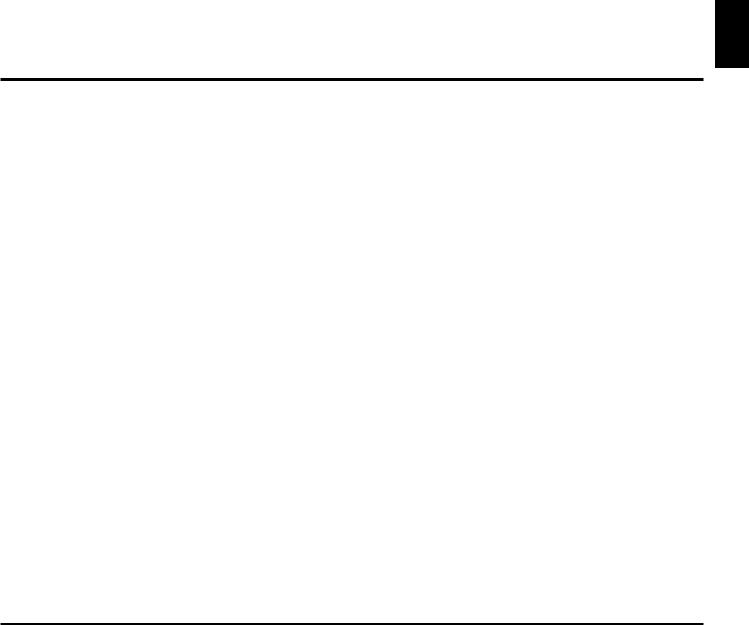
Thank you for selecting this YAMAHA stereo receiver.
FEATURES
●5 Speaker Configuration
Front: (U.S.A. and Canada models) 75W + 75W (8Ω ) RMS Output
Power, 0.04% THD, 20-20,000 Hz
(Australia and General models) 70W + 70W (8Ω ) RMS Output
Power, 0.04% THD, 20–20,000 Hz
Center: (U.S.A. and Canada models) 75W (8Ω ) RMS Output
Power, 0.07% THD, 1 kHz
(Australia and General models) 70W (8Ω ) RMS Output
Power, 0.07% THD, 1 kHz Rear: 20W + 20W (8Ω ) RMS Output
Power, 0.3% THD, 1 kHz
●Digital Sound Field Processor
6 Programs for Digital Sound Field Processing
2 Programs for Dolby Surround Decoding (DOLBY PRO LOGIC and DOLBY PRO LOGIC ENHANCED)
●Automatic Input Balance Control for Dolby Surround
●Test Tone Generator for Easier Speaker Output Balance Adjustment
●3 Center Channel Modes (NORMAL/WIDE/PHANTOM)
●40-Station Random Access Preset Tuning
●Automatic Preset Tuning
●Preset Station Shifting Capability (Preset Editing)
●IF Count Direct PLL Synthesizer Tuning System
●Video Signal Input/Output Capability
●SLEEP Timer
●Remote Control Capability
English
CONTENTS
Supplied Accessories ...................................... |
2 |
Caution ............................................................ |
4 |
Profile of This Unit ........................................... |
5 |
Speaker Setup for This Unit ............................ |
6 |
Connections .................................................... |
7 |
Speaker Balance Adjustment ........................ |
12 |
Basic Operations ........................................... |
15 |
Tuning Operations ......................................... |
18 |
Preset Tuning ................................................ |
19 |
Using Digital Sound Field Processor (DSP) |
|
...................................................................... |
22 |
Setting the SLEEP Timer .............................. |
26 |
Remote Control Transmitter .......................... |
27 |
Troubleshooting ............................................. |
33 |
Specifications ................................................ |
34 |
3

CAUTION : READ THIS BEFORE OPERATING YOUR UNIT.
1.To assure the finest performance, please read this manual carefully. Keep it in a safe place for future reference.
2.Install this unit in a cool, dry, clean place – away from windows, heat sources, sources of excessive vibration, dust, moisture and cold. Avoid sources of humming (transformers, motors). To prevent fire or electrical shock, do not expose the unit to rain or water.
3.Never open the cabinet. If something drops into the set, contact your dealer.
4.Do not use force on switches, controls or connection wires. When moving the unit, first disconnect the power plug and the wires connected to other equipment. Never pull the wires themselves.
5.The openings on the cabinet assure proper ventilation of the unit. If these openings are obstructed, the temperature inside the cabinet will rise rapidly and eventually damage the circuits. Therefore, avoid placing objects against these openings and do not install the unit where the flow of air through the ventilation openings could be impeded.
6.Always set the VOLUME control to “–∞ ” before starting the audio source play. Increase the volume gradually to an appropriate level after playback has been started.
7.Do not attempt to clean the unit with chemical solvents; this might damage the finish. Use a clean, dry cloth.
8.Be sure to read the “TROUBLESHOOTING” section regarding common operating errors before concluding that the unit is faulty.
9.When not planning to use this unit for long periods of time (ie., vacation, etc.), disconnect the AC power plug from the wall outlet.
10.To prevent lightning damage, disconnect the AC power plug and disconnect the antenna cable when there is an electrical storm.
11.Grounding or polarization – Precautions should be taken so that the grounding or polarization of an appliance is not defeated.
12.AC outlet
Do not connect audio equipment to the AC outlet on the rear panel if that equipment requires more power than the outlet is rated to provide.
13.Voltage Selector (General Model only)
The voltage selector on the rear panel of this unit must be set for your local main voltage BEFORE plugging into the AC main supply.
Voltages are 110/120/220/240V AC, 50/60 Hz.
IMPORTANT
Please record the serial number of this unit in the space below.
Serial No.:
The serial number is located on the rear of the unit. Retain this Owner’s Manual in a safe place for future reference.
WARNING
TO REDUCE THE RISK OF FIRE OR ELECTRIC SHOCK, DO NOT EXPOSE THIS UNIT TO RAIN OR MOISTURE.
CAUTION (FOR CANADA MODEL)
TO PREVENT ELECTRIC SHOCK, MATCH WIDE BLADE OF PLUG TO WIDE SLOT AND FULLY INSERT.
FOR CANADIAN CUSTOMERS
THIS DIGITAL APPARATUS DOES NOT EXCEED THE “CLASS B” LIMITS FOR RADIO NOISE EMISSIONS FROM DIGITAL APPARATUS SET OUT IN THE RADIO INTERFERENCE REGULATIONS OF THE CANADIAN DEPARTMENT OF COMMUNICATIONS.
The apparatus is not disconnected from the AC power source as long as it is connected to the wall outlet, even if the apparatus itself is turned off.
FREQUENCY STEP switch (General Model only)
Because the interstation frequency spacing differs in different areas, set the FREQUENCY STEP switch (located at the rear) according to the frequency spacing in your area. Before setting this switch, disconnect the AC power plug of this unit from the AC outlet.
4

PROFILE OF THIS UNIT
You are the proud owner of a Yamaha stereo receiver –an extremely sophisticated audio component. The Digital Sound Field Processor (DSP) built into this unit takes full advantage of Yamaha’s undisputed leadership in the field of digital audio processing to bring you a whole new world of listening experiences. Follow the instructions in this manual carefully when setting up your system, and this unit will sonically transform your room into a wide range of listening environments –movie theater, concert hall, and so on. In addition, you get incredible realism from Dolby-encoded video sources using the built-in Dolby Pro Logic Surround Decoder. Please read this operation manual carefully and store it in a safe place for later reference.
English
Digital Sound Field Processing
What is it that makes live music so good? Today’s advanced sound reproduction technology lets you get extremely close to the sound of a live performance, but chances are you’ll still notice something missing: the acoustic environment of the live concert hall. Extensive research into the exact nature of the sonic reflections that create the ambience of a large hall has made it possible for Yamaha engineers to bring you this same sound in your own listening room, so you’ll feel all the sound of a live concert.
What’s more, our technicians, armed with sophisticated measuring equipment, have even made it possible to capture the acoustics of a variety of venues such as an actual concert hall, theater, etc. to allow you to accurately recreate one of several actual live performance environments, all in your own home.
Dolby Pro Logic Surround
The Dolby Pro Logic Surround Decoder program lets you experience the dramatic realism and impact of Dolby Surround movie theater sound in your own home. Dolby Pro Logic gets its name from its professional-grade steering logic circuitry, which provides greater effective front and rear channel separation for a much higher degree of realism than the “passive” Dolby Surround circuits found in less sophisticated home audio/video equipment. Dolby Pro Logic Surround provides a true center channel, so that there are four independent channels, unlike passive Dolby Surround which has in effect only three channels: left, right, and rear. This center channel allows listeners seated in even less-than-ideal positions to hear the dialog originating from action on the screen while getting a stereo effect as well.
This Dolby Pro Logic Surround Decoder employs a digital signal processing system. This system increases sound stability at each channel and minimizes crosstalk between channels compared to conventional analog Dolby signal processing.
In addition, this unit features a built-in automatic input balance control. This circuit always presents you the best surround conditions without performing manual adjustments.
Dolby Pro Logic Surround + DSP
You can also enjoy a combination of Dolby Pro Logic Surround and DSP in the sound field program “  PRO LOGIC ENHANCED”.
PRO LOGIC ENHANCED”.
It recreates the surround effect of a movie theater, effectively duplicating its multiple surround loudspeaker system, completely surrounding the listener with the sounds of the action taking place on the screen.
5
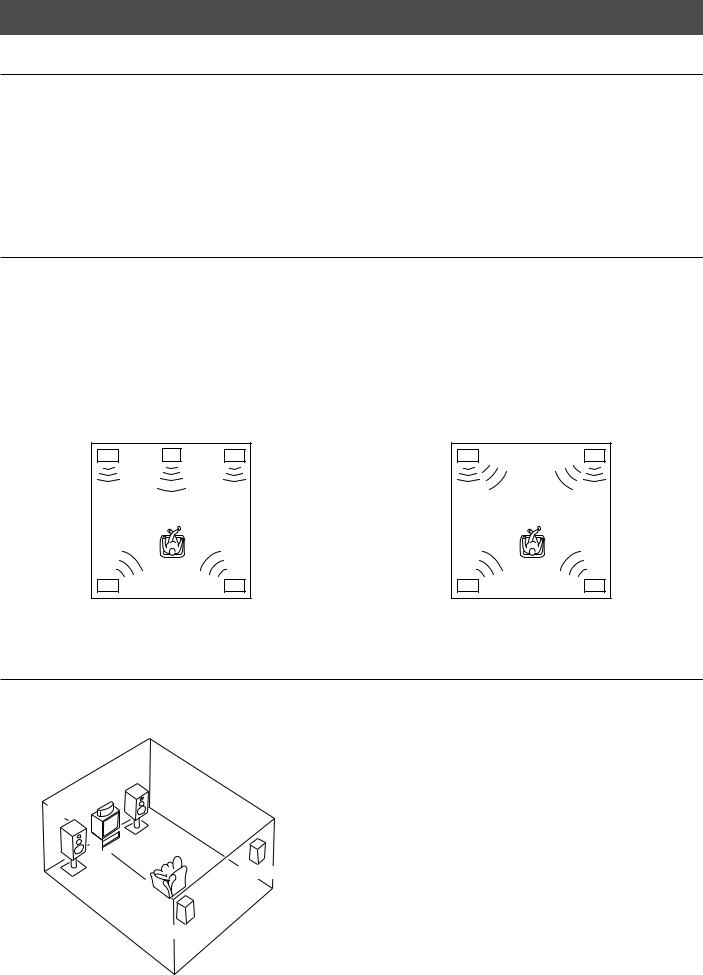
SPEAKER SETUP FOR THIS UNIT
SPEAKERS TO BE USED
This unit is designed to provide the best sound-field quality with a 5 speaker configuration. The speakers to be used with this unit will be mainly front speakers, rear speakers, and a center speaker. (You can omit the center speaker. Refer to the “4-Speaker Configuration” shown below.)
The front speakers are used for the main source sound and the effect sound. They will probably be the speakers of your present stereo speaker system. The rear speakers are used for the effect sound. And the center speaker is used for the center sound (dialog etc.) encoded with the Dolby Surround. The rear and center speakers do not need to be equal in power to the front speakers. However, all the speakers should have high enough power handling to accept the maximum output of this unit.
SPEAKER CONFIGURATION
5-Speaker Configuration
This configuration is the most effective and recommended one. In this configuration, the center speaker is necessary as well as the rear speakers. If the digital sound field program DOLBY PRO LOGIC or DOLBY PRO LOGIC ENHANCED is selected, conversations will be output from the center speaker and the ambience will be excellent.
●Set the center channel mode to the “NORMAL” or “WIDE” position. (For details, refer to page 13.)
Front L |
Center |
Front R |
Dialogue
4-Speaker Configuration
The center speaker is not used in this configuration. If the digital sound field program DOLBY PRO LOGIC or DOLBY PRO LOGIC ENHANCED is selected, the center sound is output from the left and the right front speakers. However, the sound effect of other programs can be the same as that of the 5-speaker configuration.
●Be sure to set the center channel mode to the “PHANTOM” position. (For details, refer to page 13.)
Front L |
Front R |
Dialogue
Surround sound |
Surround sound |
||
Rear L |
Rear R |
Rear L |
Rear R |
SPEAKER PLACEMENT
The recommended speaker configuration, the 5-speaker configuration, will require two speaker pairs: front speakers (your normal stereo speakers), and rear speakers, plus a center speaker. When you place these speakers, refer to the following.
Front R
Center
Front L
 TV set
TV set
Rear R
Front: In normal position. (The position of your present stereo speaker system.)
Rear: Behind your listening position, facing slightly inward. Nearly six feet (approx. 1.8 m) up from the floor.
Center: Precisely between the front speakers. (To avoid interference with TV sets, use a magnetically shielded speaker.)
Rear L
6
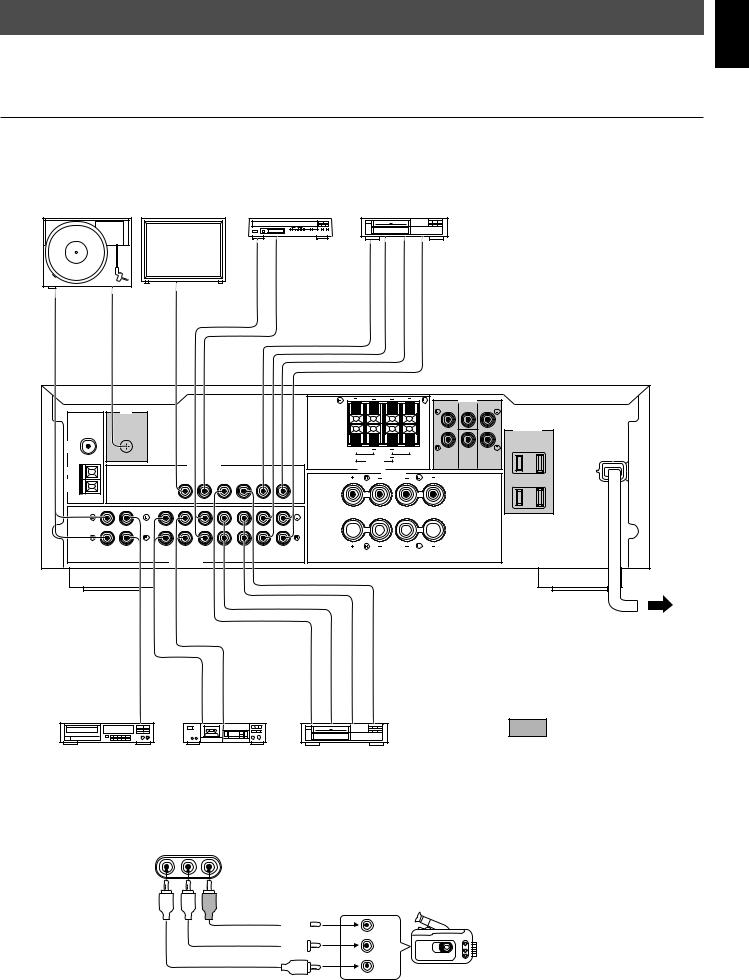
CONNECTIONS
Before attempting to make any connections to or from this unit, be sure to first switch OFF the power to this unit and to any other components to which connections are being made.
CONNECTIONS WITH OTHER COMPONENTS
When making connections between this unit and other components, be sure all connections are made correctly, that is to say L (left) to L, R (right) to R, “+” to “+” and “–” to “–”. Also, refer to the owner’s manual for each component to be connected to this unit.
|
|
|
|
LD player, |
|
|
|
|
|
Turntable |
Monitor TV |
|
TV tuner, etc. |
Video cassette recorder 2 |
|||
OUTPUT |
GND |
VIDEO IN |
AUDIO OUT |
VIDEO OUT |
VIDEO OUT |
AUDIO OUT |
VIDEO IN |
AUDIO IN |
(U.S.A. model)
|
GND |
|
|
|
|
|
|
|
75Ω UNBAL. |
|
|
|
|
|
|
|
|
FM |
|
|
|
|
|
|
|
|
ANT |
|
|
|
|
|
|
|
|
|
|
|
VIDEO SIGNAL |
|
|
|
|
|
GND |
|
|
MONITOR |
LD/TV |
IN |
VCR 1 |
IN |
VCR 2 |
|
|
|
OUT |
|
OUT |
OUT |
||
AM |
|
|
|
|
|
|
|
|
ANT |
|
|
|
|
|
|
|
|
|
|
TAPE |
REC |
|
IN |
OUT |
IN |
OUT |
|
|
PB |
OUT |
|
||||
PHONO |
CD |
TAPE |
LD/TV |
|
VCR 1 |
|
VCR 2 |
|
AUDIO SIGNAL
8ΩMIN. |
|
OUTPUT |
|
|
/SPEAKER |
|
FRONT |
REAR |
|
|
REAR |
|
|
|
|
|
|
|
AC OUTLETS |
|
CENTER |
|
|
I20W MAX. TOTAL |
|
|
|
|
|
|
C |
D |
|
l20W MAX. TOTAL |
|
|
I.0A MAX. TOTAL |
||
|
|
DUAL |
LOW |
MAINS |
C |
D:4ΩMIN./SPEAKER |
SINGLE |
PASS |
|
SINGLE:8ΩMIN./SPEAKER SPEAKERS |
fc:200Hz |
|
||
|
|
|||
|
|
SPEAKERS |
|
|
|
A |
|
A |
|
A OR B:8ΩMIN.
/SPEAKER A B:l6ΩMIN.
B:l6ΩMIN.
/SPEAKER
B 


 B
B
FRONT
English
OUTPUT |
LINE OUT |
LINE IN |
VIDEO OUT |
AUDIO OUT |
AUDIO IN |
VIDEO IN |
CD player |
Tape deck |
Video cassette recorder 1 |
||||
CONNECTING TO VIDEO AUX TERMINALS (ON THE FRONT PANEL)
These terminals are used to connect any video input source such as a camcorder to this unit.
 VIDEO AUX
VIDEO AUX
VIDEO |
L AUDIO R |
AUDIO OUT R
R
AUDIO OUT L
L
VIDEO OUT
VIDEO
Camcorder
To AC outlet
:Refer to “ABOUT THE ACCESSORY TERMINALS” on page 10.
7
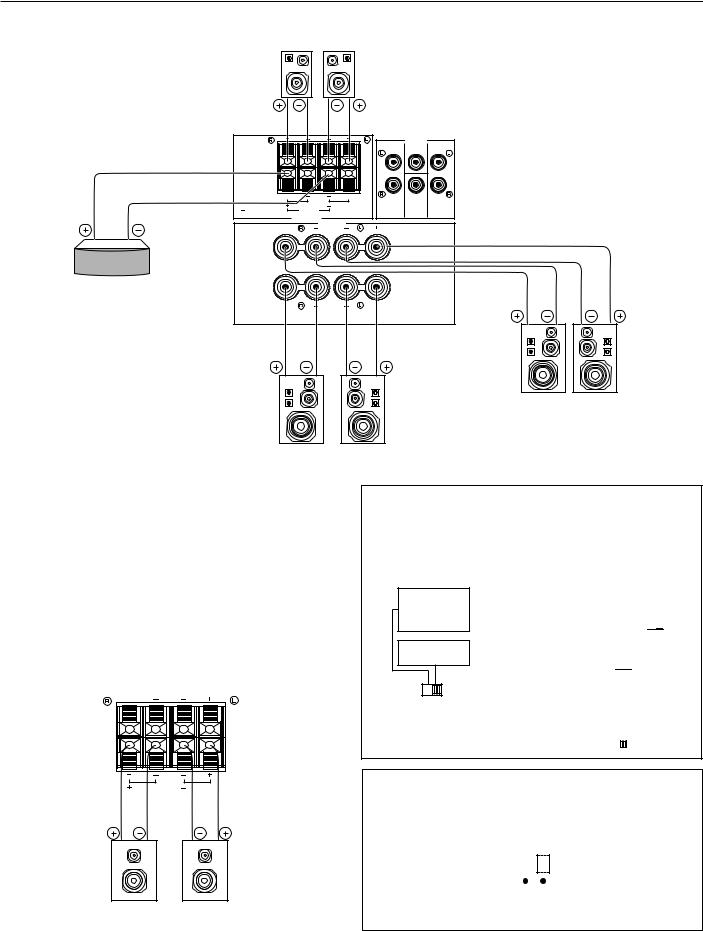
CONNECTING SPEAKERS
Connect the respective speakers to this unit as figured below.
Rear speakers
Right |
Left |
Center speaker
8ΩMIN. |
|
|
OUTPUT |
|
/SPEAKER |
|
FRONT |
REAR |
|
|
REAR |
|
|
|
|
CENTER |
|
|
|
|
|
C |
D |
|
|
|
DUAL |
|
LOW |
C |
D:4ΩMIN./SPEAKER |
SINGLE |
|
PASS |
|
fc:200Hz |
|||
SINGLE:8ΩMIN./SPEAKER SPEAKERS |
|
|||
|
|
|||
|
|
SPEAKERS |
|
|
|
A |
|
A |
|
B |
B |
FRONT
Right |
Left |
Right |
Left |
Front speakers A
Front speakers B
Note on front speaker connection:
One or two speaker systems can be connected to this unit. If you connect only one speaker system, connect it to either the SPEAKERS A or B terminals.
Note on center speaker connection:
One or two center speakers can be connected to this unit. If you cannot place the center speaker on or under the TV, it is recommended to use two center speakers and place them on both sides of the TV to orient the center sound at the center position.
For connecting two center speakers, follow the method shown below.
REAR |
|
CENTER |
|
C |
D |
|
DUAL |
 SINGLE
SINGLE
Center speaker Center speaker
IMPEDANCE SELECTOR switch (Canada model only)
Be sure to switch this only when the power of this unit is turned off. Select the position proper for the use of your front speakers.
A OR B:USE 4ΩMIN.
/SPEAKER A  B:USE 8ΩMIN.
B:USE 8ΩMIN.
/SPEAKER
A OR B:USE 8ΩMIN.
/SPEAKER
IMPEDANCE
SELECTOR
SELECTEUR D’IMPEDANCE
When using one pair of front speakers;
•If the impedance of each speaker is 8Ω or higher, set to right ( 





 ).
).
•If the impedance of each speaker is 4Ω or higher, but lower than 8Ω , set to left ( 





 ).
).
When using two pairs of front speakers;
The impedance of each speaker must be 8Ω or higher.
Set this switch to left ( |
|
). |
FRONT LEVEL switch (Australia model only)
Normally set to “0 dB”. If desired, you can decrease the output level at the FRONT SPEAKERS terminals by 10 dB by setting this switch to “–10 dB”.
|
|
|
|
|
|
|
|
|
|
|
|
l |
l0 dB 0 dB |
||||
|
FRONT |
||||
|
LEVEL |
||||
8
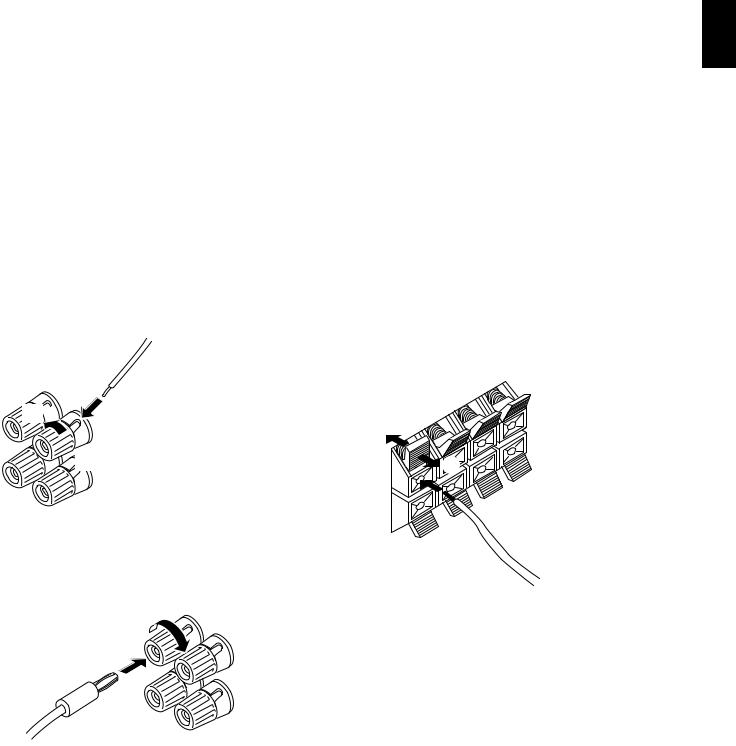
How to Connect:
Connect the SPEAKERS terminals to your speakers with wire of the proper gauge, cut as short as possible. If the connections are faulty, no sound will be heard from the speakers. Make sure that the polarity of the speaker wires is correct, that is, + and – markings are observed. If these wires are reversed, the sound will be unnatural and will lack bass.
Do not let the bare speaker wires touch each other and do not let them touch the metal parts of this unit as this could damage this unit and/or speakers.
Note
Use speakers with the specified impedance shown on the rear of this unit.
For connecting to the FRONT SPEAKERS terminals
Red: positive (+) Black: negative (–)
2
1

 3
3
Unscrew the knob.
Insert the bare wire. [Remove approx. 5mm (1/4”) insulation from the speaker wires.]
Tighten the knob and secure the wire.
<U.S.A., Canada and General models only>
Banana Plug connections are also possible. Simply insert the Banana Plug connector into the corresponding terminal.
English
For connecting to the REAR and CENTER SPEAKERS terminals
Red: positive (+)
Black: negative (–)
|
|
Press up the tab. |
|
|
Insert the bare wire. |
|
|
[Remove approx. 5mm |
|
|
(1/4”) insulation from |
|
the speaker wires.] |
|
|
|
Release the tab and |
|
secure the wire. |
|
|
|
9
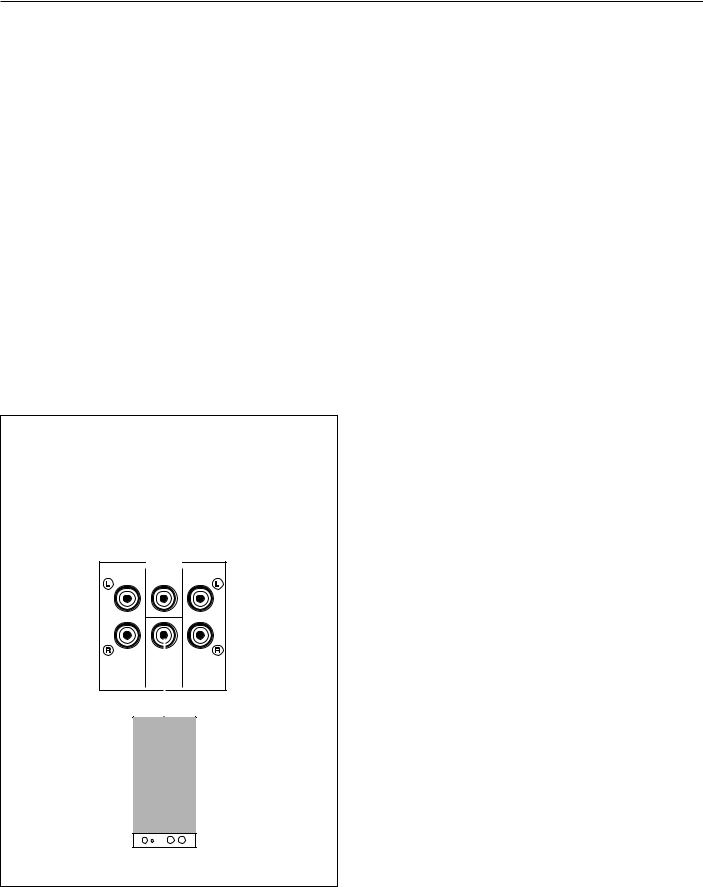
ABOUT THE ACCESSORY TERMINALS
AC OUTLET(S) (SWITCHED)
(U.S.A., Canada and General models)
........................................................... |
2 SWITCHED OUTLETS |
(Australia model) ................................. |
1 SWITCHED OUTLET |
Use these to connect the power cords from your components to this unit.
The power to the SWITCHED outlets is controlled by this unit’s POWER switch or the provided remote control transmitter’s POWER key. These outlets will supply power to any component whenever this unit is turned on.
The maximum power (total power consumption of components) that can be connected to the SWITCHED AC OUTLET(S) is 120 watts.
GND terminal (For turntable use)
Connecting the ground wire of the turntable to this terminal will normally minimize hum, but in some cases better results may be obtained with the ground wire disconnected.
LOW PASS terminal
This terminal is for output to a monaural amplifier driving a subwoofer. Only frequencies below 200 Hz from the front and center channels are output.
ADDING A SUBWOOFER
You may wish to add a subwoofer to reinforce the bass frequencies.
Connect the LOW PASS terminal to the INPUT terminal of the subwoofer amplifier, and connect the speaker terminals of the subwoofer amplifier to the subwoofer.
With some subwoofers, including the Yamaha Active Servo Processing Subwoofer System, the amplifier and subwoofer are in the same unit.
OUTPUT
FRONT CENTER REAR
LOW
PASS fc:200Hz
Subwoofer system
FRONT OUTPUT terminals
These terminals are for front channel line output. There is no connection to these terminals when you use the built-in amplifier.
However, if you drive front speakers with an external stereo power amplifier, connect the input terminals of the external amplifier (MAIN IN or AUX terminals of a power amplifier or an integrated amplifier) to these terminals.
REAR OUTPUT terminals
These terminals are for rear channel line output. There is no connection to these terminals when you use the built-in amplifier.
However, if you drive rear speakers with an external stereo power amplifier, connect the input terminals of the external amplifier (MAIN IN or AUX terminals of a power amplifier or an integrated amplifier) to these terminals.
CENTER OUTPUT terminal
This terminal is for center channel line output. There is no connection to this terminal when you use the built-in amplifier. However, if you drive a center speaker with an external power amplifier, connect the input terminal of the external amplifier to this terminal.
10
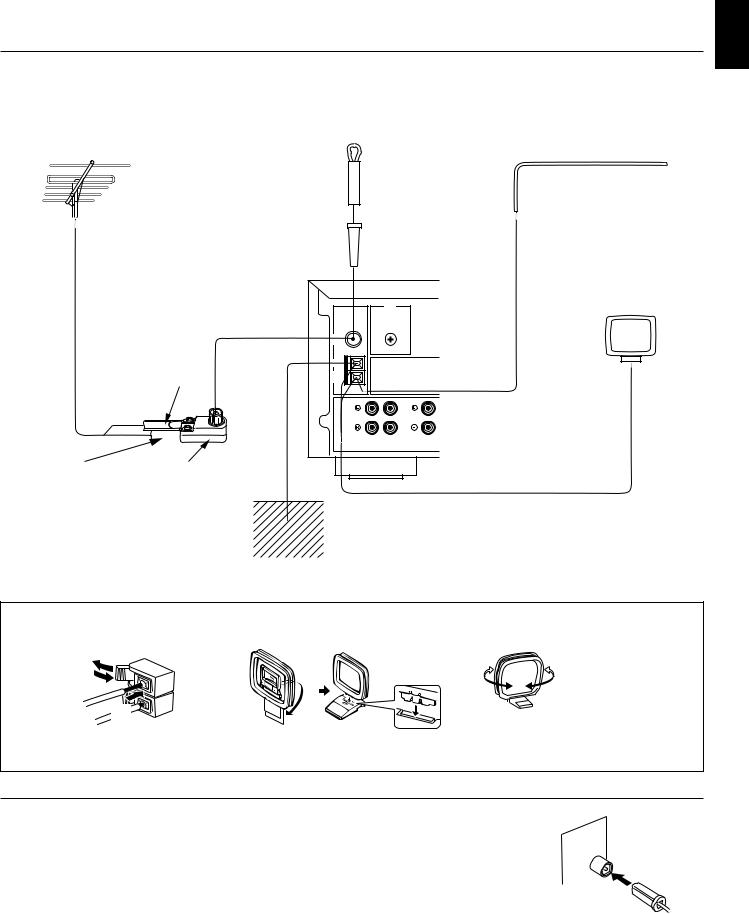
ANTENNA CONNECTIONS
●Each antenna should be connected to the designated terminals correctly, referring to the following diagram.
●Both AM and FM indoor antennas are included with this unit. In general, these antennas will probably provide sufficient signal strength. Nevertheless, a properly installed outdoor antenna will give clearer reception than an indoor one. If you experience poor reception quality, an outdoor antenna may result in improvement.
Outdoor FM antenna |
Indoor FM |
Outdoor AM antenna |
|
antenna |
|
|
(included) |
|
English
300-ohm feeder
75-ohm |
|
|
|
|
|
|
|
|
|
|
|
|
|
|
|
|
|
|
|
|
|
|
|
|
|
|
|
|
|
|
|
75-ohm/300-ohm |
|
||||||
coaxial cable |
antenna adapter |
|
|||||
|
|
|
|
|
|
|
|
|
|
|
|
|
|
|
|
|
|
AM loop |
|
|
antenna |
|
GND |
(included) |
75Ω UNBAL. |
|
|
FM |
|
|
ANT |
|
|
GND |
|
|
AM |
|
|
ANT |
|
|
|
|
TAPE |
PHONO |
CD |
PB |
|
Ground
Connecting the AM loop antenna
1 |
2 |
3 |
*The AM loop antenna should be placed apart from the main unit. The antenna may be hung on a wall.
*The AM loop antenna should be kept connected, even if an outdoor AM antenna is connected to this unit.
GND terminal
For maximum safety and minimum interference, connect the GND terminal to a good earth ground. A good earth ground is a metal stake driven into moist earth.
Notes
●When connecting the indoor FM antenna, insert its connector into the FM ANT
terminal firmly. ● If you need an outdoor
FM antenna to improve FM reception quality, either
300-ohm feeder or coaxial cable may be used. In locations troubled by electrical interference, coaxial cable is preferable.
11
